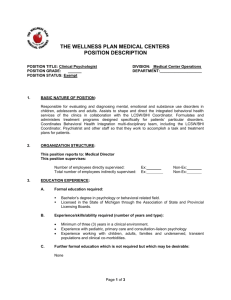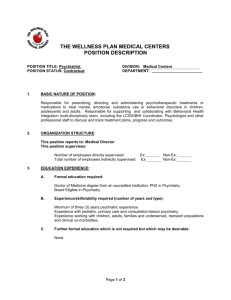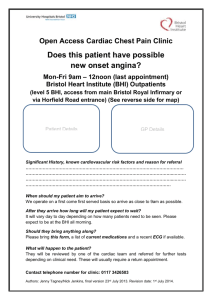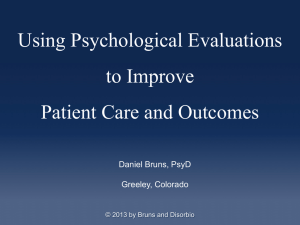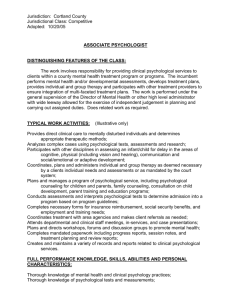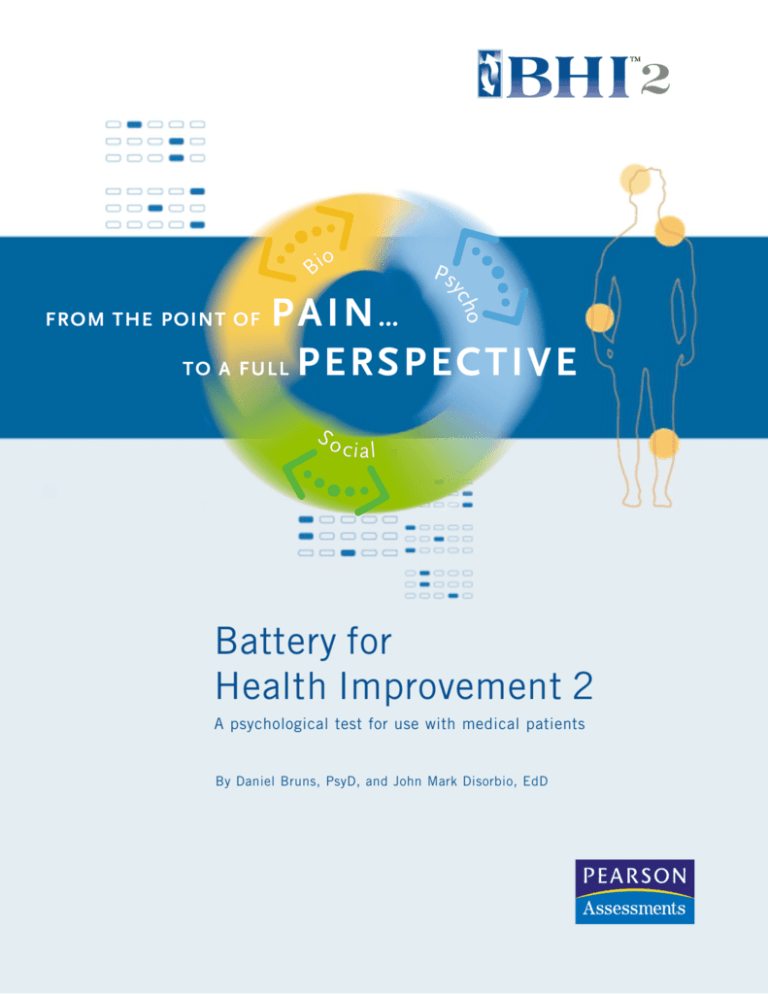
o
Bi
Ps
o
ych
PAIN …
TO A FULL PERSPECTIVE
FROM THE POINT OF
So
cial
Battery for
Health Improvement 2
A psychological test for use with medical patients
By Daniel Bruns, PsyD, and John Mark Disorbio, EdD
BATTERY FOR
HEALTH IMPROVEMENT 2
By Daniel Bruns, PsyD, and John Mark Disorbio, EdD
A multidimensional tool to help
psychologists and medical professionals
understand the underlying contributors
to pain and lead their patients
to fuller lives.
“Behind patient behavior is suffering,
behind suffering is pain,
behind pain is a medical condition.”
or medical practitioners, a pain scale or diagram is
a familiar tool. But in evaluating medical patients,
the point of pain is only a point of departure.
Research into the mind/body connection shows
that physical, psychological, and social factors all are
facets of the patient’s condition – and that these elements
can greatly influence one another. For example, physical
pain can lead to emotional distress, which can increase a
patient’s overall level of suffering. This in turn can put
stress on a patient’s personal relationships. In other cases,
such as tension headaches, emotional distress can
actually be the cause of pain.
F
The interplay of bio/
psycho/social factors
calls for a transformation
in the way practitioners
perceive their patients.
Discovering the true
source of the problem depends on looking at the patient
not from a single vantage point but from various angles.
To help reveal the patient’s multifaceted experience, the
BHI 2 assessment provides a psychological test that offers
a multidimensional solution.
The BHI 2 instrument can be useful in the assessment
of outcomes – because psychological and social factors
that go undetected can significantly interfere with
a patient’s response to treatment. Based on the
well-researched BHI instrument introduced in 1996,
the BHI 2 test helps caregivers shape an appropriate
treatment plan, reduce treatment time, and improve
the patient’s quality of life.
1
SUPPORTING A SHARED PERSPECTIVE
Before designing a treatment plan, mental health and
medical professionals can use the BHI 2 test results as a
basis for sharing and discussing a patient’s psychological
findings in conjunction with physical findings. The test
also facilitates communication with the patient, providing
a Patient Summary written in layperson’s language.
PROFILING OUTCOMES
The BHI 2 test can be used to help monitor and track
outcomes in a variety of settings. It can be administered
to track the effectiveness of clinical procedures and
treatment for an individual patient as well as to track
outcomes data collected over a broad patient base.
A large body of research shows a strong relationship
between a variety of psychological factors and the onset of
medical conditions, physical symptom magnification,
delayed recovery, excessive disability, and failed surgery or
procedures. Many of these psychological factors are
assessed by the BHI 2.
In addition, multidisciplinary pain clinics can use the
BHI 2 instrument in conjunction with the shorter
BBHI™ 2 test (see sidebar) to gain “before and after”
portraits of candidates for invasive procedures. Prior to
the procedure, the BHI 2 test can be administered to
determine the patient’s readiness. After the procedure, the
BBHI 2 test can be administered to monitor the patient’s
improvement. Using two tests within the same family of
instruments enables the clinician to compare “apples to
apples” — a benefit not offered by the majority of
psychological tests.
ALL-IN-ONE TOOL GIVES A PANORAMIC VIEW
Many practitioners, recognizing the need to consider
a variety of factors in assessing their patients, use
three or four tests to gather patient information.
Unfortunately, these tests often overlap, proving cumbersome and time-consuming for both patients and staff – and,
what’s worse, they still may not paint a complete picture.
The BHI 2 test is specifically designed to present a
concise, coordinated assessment of the bio/psycho/social
issues that are most relevant in evaluating medical
patients. Taking only 30 to 45 minutes to complete,
the BHI 2 test helps streamline the process. And it is
well-suited for evaluating treatment effectiveness and
monitoring clinical outcomes by clearly documenting
changes in symptom levels.
USEFUL FOR MULTIPLE SETTINGS
The versatile BHI 2 test has proven valuable for a
number of applications, including:
■
Multidisciplinary pain programs
■
Interventional pain medicine
■
Physical rehabilitation programs
■
Pre-surgical evaluations
■
Workers’ compensation evaluations
■
Disability evaluations
■
Independent medical evaluations
Distinctive Elements Compose a Unique Test
IN-DEPTH RESEARCH PROVIDES
EXTENSIVE VALIDATION
CRITICAL ITEMS HIGHLIGHT
RED-FLAG ISSUES
BHI 2
Building on the research conducted for
the original BHI test, the BHI 2 test was
double-normed, using a U.S. Censusmatched sample of 725 community
individuals and a national sample of 527
physical rehabilitation and chronic pain
patients. The reports compare the patient
to both norm groups and use the average
physical rehabilitation patient as a benchmark for interpretations and recommendations, reducing the risk of overpathologizing.
The revised BHI 2 test includes 31 critical
items that draw attention to a wide variety
of risk factors, such as suicidal ideation,
addiction concerns, entitlement, and
home-life problems. When a critical item
is endorsed, further investigation is
warranted because these areas may require
treatment and may complicate the course
of a patient’s recovery.
REPORT COMPONENTS
40 CONTENT AREAS ADD
GREATER DEFINITION
Within each scale, content areas help
distinguish the specific reasons for a
patient’s psychological or psychosocial
problems. For example, content areas
within the Doctor Dissatisfaction scale
measure the patient’s perceptions of his/her
doctor’s level of competence and empathy.
Presented in graphic format, this additional
delineation helps further support suitable
treatment plans.
PATIENT PROFILE
PROFILE
X
SCALE SUMMARY
BASIC SCALE INTERPRETATION
ENHANCED SCALE INTERPRETATION
PAIN COMPLAINTS ITEM RESPONSES
BI-DIRECTIONAL SCALES SHOW
BOTH SIDES OF THE PICTURE
DIAGNOSTIC PROBABILITIES
While most other psychological assessments
focus only on the areas in which a patient
scores above the norm, the BHI 2 test
reports scores below the norm. For example,
the test reports the patient’s perception
of whether his/her family is too helpful or
not helpful enough.
REPORTS OFFER DIFFERENT
LEVELS OF DETAIL
Three reports are available —the Profile
Report, the Basic Interpretive Report,
and the Enhanced Interpretive Report
— allowing clinicians to choose the
option that best fits their needs.
SOMATIC COMPLAINTS ITEM RESPONSES
CRITICAL ITEMS
X
CONTENT AREA PROFILE
X
OMITTED ITEMS
(IF APPLICABLE)
X
TREATMENT RECOMMENDATIONS
(OPTIONAL)
ITEM RESPONSES
(OPTIONAL)
PATIENT SUMMARY
(OPTIONAL)
Establishing a Well-defined Measure:
Making a Critical Distinction:
A Nationally Normed Pain Scale
Survivor of Violence Scale
A unique feature of the BHI 2 test is its use of a nationally
standardized 0–10 pain rating scale that helps measure
multiple dimensions of the pain experience, including
level of pain in 10 body areas, pain tolerance, pain range,
and peak pain.
This unique scale was developed for the BHI 2 test to
help identify survivors of violence, whose needs may be
significantly different from those of the average patient.
Research shows that survivors of violence are at
increased risk for the onset of a variety of psychological
and medical conditions. Patients who have been
physically traumatized may feel uncomfortable with
physical examination or disrobing. Treatment strategies
that might prove effective with other individuals, such as
massage therapy, may be perceived as threatening and
may lead to an aversive reaction. In addition, survivors
may be more reactive to stress, exhibit highter levels of
physical symptomatology, and be at increased risk for
delayed recovery. The BHI 2 test helps bring this critical
factor to the forefront early in the evaluation process.
X
Focusing on psychomedical issues
relevant to medical practitioners
SCALES
BASIC
ENHANCED
INTERPRETIVE
INTERPRETIVE
X
X
X
X
X
X
X
Validity Scales
■
Defensiveness
■
Self-Disclosure
Physical Symptom Scales
■
Somatic Complaints
■
Pain Complaints
■
Functional Complaints
■
Muscular Bracing
X
X
X
X
X
X
X
X
X
X
X
X
X
X
X
Also available from
Pearson Assessments is the
BBHI™ 2 (Brief Battery for
Health Improvement 2)
assessment, a shorter version
of the BHI 2 instrument.
In contrast to the more
extensive BHI 2 test, the
BBHI 2 test was developed
as a quick screener to help
medical practitioners assess
psychomedical factors
commonly seen in medical
patients, such as pain and
somatic complaints, along
with the ability to function –
as well as traditional
psychological concerns
such as depression, anxiety,
and defensiveness.
Affective Scales
■
Depression
■
Anxiety
■
Hostility
Character Scales
■
Borderline
■
Symptom Dependency
■
Chronic Maladjustment
■
Substance Abuse
■
Perseverance
Psychosocial Scales
■
Family Dysfunction
■
Survivor of Violence
■
Doctor Dissatisfaction
■
Job Dissatisfaction
Enabling Finer Discriminations:
Additional Reference Groups
Because the BBHI 2 and BHI 2 share a common framework,
they can be used to:
■
conduct a coordinated two-step evaluation process. The
BBHI 2 test can be given as a screener followed by the
BHI 2 test to gather more comprehensive information.
■
track outcomes. The BHI 2 test can be administered as
a pre-procedural assessment and the BBHI 2 test can be
used for follow-up evaluations.
Reimbursement
Although reimbursement policies vary, many third-party
As well as comparing the patient to the community
sample and the patient sample, the BHI 2 instrument adds
depth of field to the clinician’s analysis of results by comparing
the patient to individuals with a similar condition for the five
reference groups listed below. These groups are based on
common diagnostic categories of injuries often seen in
rehabilitation settings and are used by the Pain Complaints scale.
• Head injury/headache
• Lower extremity injury
• Neck injury
• Back injury
payors recognize the efficacy of behavioral assessment
of patients with a physical health diagnosis. Many users
of assessments have found that costs can be reimbursable
under CPT codes 96150 for initial assessment and
96151 for reassessment or CPT code 96100 for
psychological assessment.
INFORMATION
• Upper extremity injury
1.888.627.7271
In addition, the Pain Complaints scale also uses a chronic pain
reference group, while the Defensiveness and Self-Disclosure
scales use reference groups for symptom magnification (Faking
Bad) and symptom minimization (Faking Good) as additional
benchmarks (or comparisons) for clinical interpretation.
Email: kelly.robbins@pearson.com
Visit our website at
www.pearsonassessments.com
About the Authors
About Pearson Assessments
Daniel Bruns, PsyD, and John Mark Disorbio, EdD, have collaborated on
psychological test development since 1985. In addition to co-authoring
the BHI™ 2 test, they are also the authors of the BBHI™ 2 (Brief Battery
for Health Improvement 2) test and BHI™ (Battery for Health Improvement)
test. Both live and practice in Colorado.
Pearson Assessments (formerly NCS Assessments) has
been a premier provider of psychological assessments
and scoring solutions for 40 years. Pearson Assessments
provides assessment tools for use by professionals in the
clinical, public safety, corrections, medical, career,
and education settings. For more information, please
call 1.888.627.7271 or visit the Pearson Assessments
website at www.pearsonassessments.com.
DANIEL BRUNS, PsyD
Dr. Bruns’s practice, Health Psychology Associates, is affiliated with the
Ramazzini Center, a multidisciplinary facility providing a range of rehabilitation
services for injured patients. In his 20 years of clinical practice, Dr. Bruns
has come to specialize in the psychological assessment and treatment of
medical patients. As a result, he has taught graduate classes and workshops
and has made numerous presentations to international, national, and regional
professional societies on psychological testing, psychopathology, somatoform
disorders, and the assessment and treatment of pain. As a member of
three task forces for the Colorado Division of Workers’ Compensation
(Psychiatric Disability, Chronic Pain, and Complex Regional Pain Syndrome),
he helped to develop evidence-based guidelines to regulate the treatment
of injured workers in Colorado. In the past, he has worked on the Chronic
Illness Team at the Wellness Center of North Colorado Medical Center.
He is also the webmaster of www.healthpsych.com. Dr. Bruns received his
MA and PsyD degrees in counseling psychology from the University of
Northern Colorado in Greeley.
JOHN MARK DISORBIO, EdD
Currently Dr. Disorbio works as a psychologist at Integrated Therapies,
an interdisciplinary outpatient clinic for evaluating and treating patients with
delayed recovery from chronic pain that he co-founded with Julia Copeland,
PT, in 1985. In addition, he is a consultant to major companies throughout
the U.S. and serves on the board of the National Pain Foundation. Having
spent the majority of his educational and clinical career in the diagnosis and
treatment of patients with psychological factors related to medical conditions,
he is a frequent presenter at national and international conferences and has
published research articles in numerous journals. An active member of the
Biofeedback Society for 20 years, he also has extensive training in biofeedback
and self-regulation techniques. Dr. Disorbio received his MA degree in
counseling psychology from California State University and his EdD degree
in counseling psychology from the University of Northern Colorado. He has
been licensed as a psychologist in the state of Colorado since 1987.
P.O. Box 1416
Minneapolis, MN 55440
Service Address Requested
Copyright ©2003 NCS Pearson, Inc. All Rights Reserved.
“BHI” and “BBHI” are trademarks of NCS Pearson, Inc.
1
Ahrold, Jill. “Providing Valuable Input.” Practical Pain
Management Mar.-Apr. 2001: 24 - 26
D99
F005BR
472-MED
03/03
INFORMATION
1.888.627.7271
Email: kelly.robbins@pearson.com
Visit our website at
www.pearsonassessments.com
About the Authors
About Pearson Assessments
Daniel Bruns, PsyD, and John Mark Disorbio, EdD, have collaborated on
psychological test development since 1985. In addition to co-authoring
the BHI™ 2 test, they are also the authors of the BBHI™ 2 (Brief Battery
for Health Improvement 2) test and BHI™ (Battery for Health Improvement)
test. Both live and practice in Colorado.
Pearson Assessments (formerly NCS Assessments) has
been a premier provider of psychological assessments
and scoring solutions for 40 years. Pearson Assessments
provides assessment tools for use by professionals in the
clinical, public safety, corrections, medical, career,
and education settings. For more information, please
call 1.888.627.7271 or visit the Pearson Assessments
website at www.pearsonassessments.com.
DANIEL BRUNS, PsyD
Dr. Bruns’s practice, Health Psychology Associates, is affiliated with the
Ramazzini Center, a multidisciplinary facility providing a range of rehabilitation
services for injured patients. In his 20 years of clinical practice, Dr. Bruns
has come to specialize in the psychological assessment and treatment of
medical patients. As a result, he has taught graduate classes and workshops
and has made numerous presentations to international, national, and regional
professional societies on psychological testing, psychopathology, somatoform
disorders, and the assessment and treatment of pain. As a member of
three task forces for the Colorado Division of Workers’ Compensation
(Psychiatric Disability, Chronic Pain, and Complex Regional Pain Syndrome),
he helped to develop evidence-based guidelines to regulate the treatment
of injured workers in Colorado. In the past, he has worked on the Chronic
Illness Team at the Wellness Center of North Colorado Medical Center.
He is also the webmaster of www.healthpsych.com. Dr. Bruns received his
MA and PsyD degrees in counseling psychology from the University of
Northern Colorado in Greeley.
JOHN MARK DISORBIO, EdD
Currently Dr. Disorbio works as a psychologist at Integrated Therapies,
an interdisciplinary outpatient clinic for evaluating and treating patients with
delayed recovery from chronic pain that he co-founded with Julia Copeland,
PT, in 1985. In addition, he is a consultant to major companies throughout
the U.S. and serves on the board of the National Pain Foundation. Having
spent the majority of his educational and clinical career in the diagnosis and
treatment of patients with psychological factors related to medical conditions,
he is a frequent presenter at national and international conferences and has
published research articles in numerous journals. An active member of the
Biofeedback Society for 20 years, he also has extensive training in biofeedback
and self-regulation techniques. Dr. Disorbio received his MA degree in
counseling psychology from California State University and his EdD degree
in counseling psychology from the University of Northern Colorado. He has
been licensed as a psychologist in the state of Colorado since 1987.
INFORMATION
1.888.627.7271
Email: kelly.robbins@pearson.com
Visit our website at
www.pearsonassessments.com
P.O. Box 1416
Minneapolis, MN 55440
D99
F005BR
472-MED
03/03
Copyright ©2003 NCS Pearson, Inc. All Rights Reserved. “BHI” and “BBHI” are trademarks of NCS Pearson, Inc.
1
Ahrold, Jill. “Providing Valuable Input.” Practical Pain Management Mar.-Apr. 2001: 24 - 26


